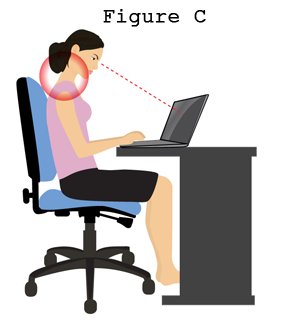Do you often feel sore and achy after a day at work? Your workstation may be playing a part in this!
Here are five helpful tips!
Tip #1 – Don’t look down!

Monitor height is often too low. If you find yourself looking down to see the screen, you’ve got a problem.
Raise your monitor so you look straight ahead. Trust me, your neck will thank you. Your head isn’t the lightest thing in the world and looking down all the time puts a lot of strain on the muscles in your neck. It can also lead to, or worsen forward head posture!
The test… Sit up straight in front of your computer as your parents told you to, and have a colleague look at your posture from the side. Then look at your monitor as if you were working. If your colleague sees your head move forward, down or most likely both, you NEED to raise your monitor.
Tip #2 – Care about the chair!

To keep your feet on the floor, arms parallel with the desk, head up, and back straight – invest in a quality office chair. You should be able to adjust the height of your chair to a level that is perfectly comfortable for you so get one with an adjustable height.
Your lower back should sit comfortably against the backrest of the chair.
Adjust your chair so your feet are firmly supported by the floor. If you have short legs or a tall workstation, consider pairing your chair with a footrest.
Tip #3 – Use a headset!

If you use the phone frequently, use a head set or a speaker phone, especially if you type or write while on the phone. If you are not using a headset hold the receiver to your ear. Do not cradle receiver between chin and shoulder!
Tip #4 – Check your wrists and elbows!

Whether you’re using a mouse or a keyboard, making sure you have enough wrist support is important not just for your wrists and helping to prevent RSI and Carpal Tunnel, but also for your shoulders, which hold a lot of tension from the awkward position.
Adjust the height of your keyboard so that, while typing, your shoulders are relaxed, wrists are flat, and elbows are bent to 90 degrees and resting at your sides (i.e., neutral).
If you can’t adjust your keyboard height, raise your chair height, and get a footrest to properly support your legs.
If you suffer from wrist pain when using a mouse try an Ergonomic Vertical Mouse as it can make a big difference.
Tip#5 Stretch!

Make sure to be taking breaks frequently to stretch your body. Don’t just move around in your chair. Get up and walk around, especially if you’re sitting at your desk for 8 hours a day! Get up and move. As muscles tire, slouching, slumping, and other poor postures become more likely; this in turn puts extra pressure on the neck and back. In order to maintain a relaxed yet supported posture, change positions frequently. One way is to take a break from sitting in an office chair every hour for two minutes in order to stretch, stand, or walk. Set a reminder or alarm on your phone to remind you every hour or so to take a short break from your desk.
Lastly, prevention is always better than cure, which is why it’s so important to have your spine checked if you experience pain for more than a couple of days.



